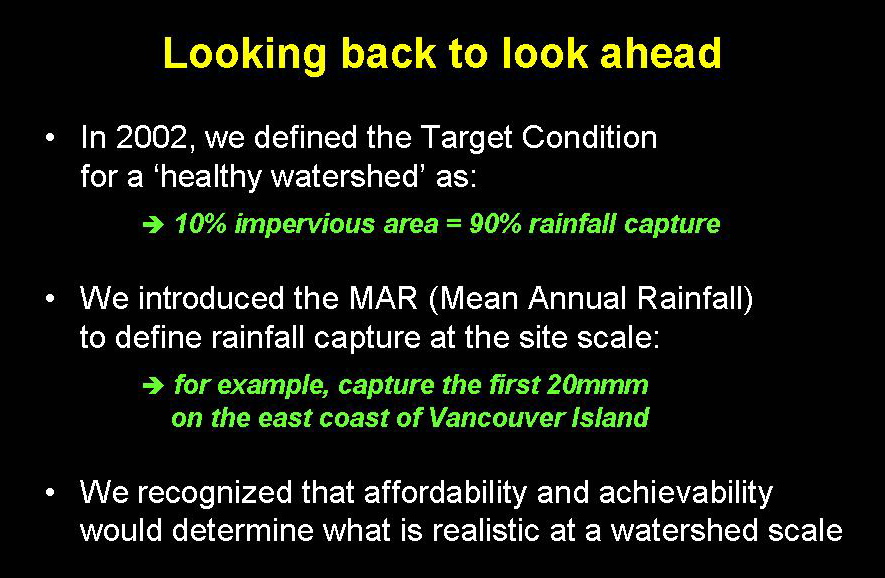Protect Stream Health: Set Achievable, Affordable and Effective Watershed Targets
Performance Target Methodology expalined at Cowichan Valley Learning Lunch Seminar #3
The Learning Lunch Seminar Series is a precedent-setting approach to continuing education for local government practitioners; and is the first step in building a regional team approach so that there will be a common understanding and consistent messaging on Vancouver Island regarding on-the-ground expectations for rainwater management and green infrastructure.
The pilot Cowichan Valley Learning Lunch Seminar Series comprised a set of three sessions held during the June-July 2008 period. The title of the third seminar was Establish Watershed Performance Targets.
 “We held the seminar in the heart of the Busy Place Creek drainage area to introduce an on-the-ground reality to the topic of performance targets,” explains Kim Stephens, team leader and Program Coordinator for the Water Sustainability Action Plan for British Columbia. ” We wanted to show participants why a performance target approach to land development makes sense, can meet multiple objectives, and thereby result in net environmental benefits at a watershed scale.
“We held the seminar in the heart of the Busy Place Creek drainage area to introduce an on-the-ground reality to the topic of performance targets,” explains Kim Stephens, team leader and Program Coordinator for the Water Sustainability Action Plan for British Columbia. ” We wanted to show participants why a performance target approach to land development makes sense, can meet multiple objectives, and thereby result in net environmental benefits at a watershed scale.
Genesis for Performance Targets
Founded on British Columbia case study experience, and published by the Province in 2002, Stormwater Planning: A Guidebook for British Columbia formalized a science-based understanding to set performance targets for reducing rainwater runoff volumes and rates. These targets represent the synthesis of biological and hydrological understanding.
Kim Stephens, principal author of the Guidebook, explained the thinking behind the use of performance targets. “Once we went back to basics and developed the concept of a Rainfall Spectrum, this then led into the concept of Performance Targets for rainwater runoff capture,” he stated. “The reason runoff percentage is the performance target is that municipalities exert control over runoff volume through their land development and infrastructure policies, practices and actions.”
Link to YouTube Video:
 To gain an appreciation for the Performance Target approach, view the set of PowerPoint slides presented by Kim Stephens while at the same time listening to the audio portion of a video clip of him elaborating on each slide. To access the video clip, click here or on the adjacent image.
To gain an appreciation for the Performance Target approach, view the set of PowerPoint slides presented by Kim Stephens while at the same time listening to the audio portion of a video clip of him elaborating on each slide. To access the video clip, click here or on the adjacent image.
Beyond the Guidebook: Establishing Watershed-Specific Targets
In 2002, “Stormwater Planning: A Guidebook for British Columbia” articulated a principle that performance targets at the watershed scale provide a starting point to guide the actions of local government in the right direction. The objective is to translate those targets into appropriate site design criteria that then provide local government staff and developers with practical guidance for achieving the goal of stream protection.
The methodology embedded in the Water Balance Model powered by QUALHYMO enables a watershed target to be established; it also enables the modeller to assess how to meet the watershed target at the site scale. The critical consideration is that the watershed target be characteristic of conditions in the watershed. When establishing a watershed-specific discharge target, three fundamental questions need to be answered:
- Could the target be achieved?
- If it could be achieved, how would it be achieved?
- Should the target be achieved?
The litmus test for an acceptable Watershed Target is that the resulting RAINwater management solutions make sense, are affordable and result in net environmental benefits at a watershed scale. For a performance target to be implemented and effective, it must have feedback loops so that adjustments and course corrections can be made over time.
To Learn More:
To download a copy of a guidance document released by the Inter-Governmental Partnership in February 2008, click on the following link to Beyond the Guidebook – Establish Watershed-Specific Runoff Capture Performance Targets.





